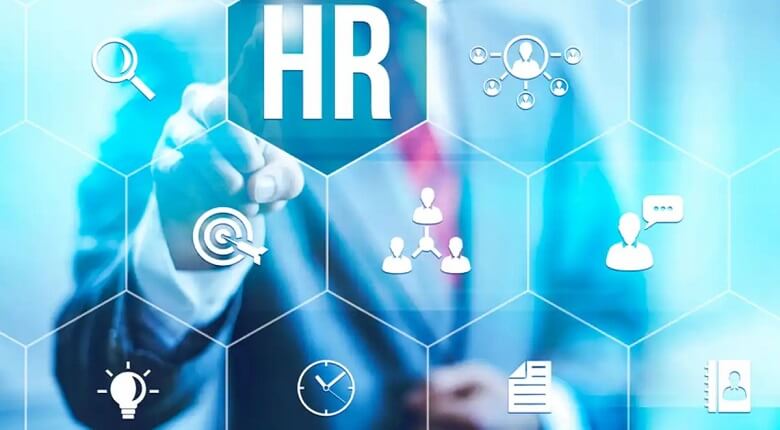- December 13, 2022
- No Comment
- 493
HRMS – Comprehensive Guide on Managing Your Human Resource

The HR team will have to manage the changing workforce manually. It cannot be easy to keep all employee data in one place. Operational HR activities become more laborious and time-consuming. This causes a gradual decline in efficiency for HR processes and the team that manages them.
Businesses can use the best HR software to streamline HR processes and store employee data in one place. Software systems streamline manual and repetitive tasks, simplify workflows, and allow HR to focus on strategic tasks and reach business goals faster.
This HRMS guide covers everything you need to know about HRMS. Let’s start by:
What is HRMS?
The common name for the complete suite of modules and processes that link HR with Information Technology is HRMS (Human Resource Management System). The automated HR software HRMS allows HR to store digitally encrypted employee data and reduce manual effort. The HRMS is a cost-saving, bandwidth-saving, and burden-reducing tool.
An HRMS tool stores employee information and helps you manage HR operations such as onboarding, leave management, payroll processing and expense management.
Many HRMS software includes a mobile app and ESS portal that allows employees to view their information from anywhere, including their pay slips, leave balance, application for leave, and upload IT proofs. This helps to increase employee productivity and organizational efficiency.
Is There a Difference Between HRIS, HRMS and HCM?
Many people confuse HRMS with HRIS or HCM. While all three terms are in the same HR domain, their features have subtle differences. Let’s take a look at each one one by one.
An HRIS (Human Resource Information System) is software designed to help employees manage their information and its processes. It also has policies about what and where it will be stored. This is the smallest term of all three. An HRIS can include core HR, attendance and leave management, training and development, benefits administration and compensation planning. It also includes reporting, workflows and a self-service portal.
HCM, Human Capital Management, is the superset of HRIS. It includes all the HRIS features and talent management features like onboarding, performance management, and learning and development.
HRMS is now the most popular of all three terms. It usually includes all of the HRIS and HCM features. It covers all aspects of HR functions and offers a variety of features that can streamline end-to-end hr processes. In addition to the HRIS and HCM features, HRMS offers labour management and payroll.
Let’s now understand the differences between each term.
What is the Purpose of an HRMS?
The working environment has changed significantly over the past decade, especially since the Covid-19 era. Remote work is no longer a luxury. Businesses must go digital if they want to survive in this volatile marketplace.
The HR solution is more cost-effective than other solutions such as ERP, accounting, CRM and CRM. It automates manual tasks that are repetitive and time-consuming and increases operational efficiency. Cloud-based HRMS provides an online repository for employee information that can be accessed anywhere.
This allows human resource professionals to focus on employee engagement, career development and retention.
Modules of the HRMS or How the HRMS Works
A perfect HRMS solution should include all the features necessary to manage an entire employee life cycle. This saves time and allows HR to focus on strategic tasks like employee retention, engagement, and productivity.
Below are the functions of HRMS Software.
- Recruitment & Onboarding
An HRMS allows HR professionals to connect to different job boards, websites, or other job posting media to post vacancies. It will allow you to schedule interviews, scan resumes and manage vacancies from one platform, which can be used to attract top talent.
The onboarding platform is included to ensure that new hires have a pleasant onboarding experience and engagement starting from day 1. Digital onboarding eliminates the need for paper and allows you to store employee data in one place securely. It also helps new hires to understand and access information about the organization’s culture, values, and goals.
- Time & Attendance
An HRMS time-and-attendance allows HR to record an employee’s punch-in and out times so that HR can see how much time was spent at work. Its powerful rule engine allows you to create policies, shifts or rotational patterns and then enforce them within your organization. The attendance management system includes features like geofencing and faces recognition. You can also punch with location and selfie tags to monitor attendance better and under more remote conditions.
- Leave Management
Like attendance, it is important to manage employees’ leave. Digital solutions allow you to set up leave policies and create multiple types of leave. Employees can check their leave balance, apply for leave and use their mobile app to access it. Managers can also quickly respond to these applications. Multi-level approval workflows are possible in an online leave management platform.
- Timesheets
Timesheets are great for organizations, especially with multiple clients or projects. Managers can track the productivity of employees by monitoring their schedules. Employees can submit tasks and the time it takes to complete them.
- Performance Management
Evaluating employees’ performance through regular reviews and feedback is called performance evaluation. The software makes it much easier to perform performance evaluations. Employees can upload their targets in the form of KRA, KPI and OKRs. Managers may conduct review cycles to evaluate the achievements and make course corrections.
You can track employee performance and link it to payroll calculations. This allows you to revise CTCs based on their achievement. This can motivate them and boost their morale.
- Payroll
Payroll processing is one of the most important but most difficult and error-prone HR functions. Many errors can be made in tasks such as collecting attendance and leave information, deducting taxes, defining CTC structures, and ensuring compliance rules are all part of the payroll processing process.
A payroll management system can solve these problems. It’s accurate, reliable, efficient, and fast. This saves HR time. It can create multiple CTC structures, establish policies and set up salary components. The inbuilt integration capabilities make all data, including attendance, leave, and performance, easily accessible during processing. No manual input is required. This digitized platform helps you to be 100% compliant with all state and central rules.
- Management of Travel & Expenses
The travel and expense platform allows you to centralize data entry while ensuring strong monitoring and control of business expenditures. It also offers flexible policy configurations, approval workflows, insight analytics, and reimbursement application to simplify your business expense calculations.
- Employee Self-Service
Employees used to have to contact HR regarding their concerns, attendance, leave balance, tax breakups and other issues. This took a lot of time for HR. It can lead to a lot of unsatisfactory responses. Modern HRMS can solve this problem. A self-service portal allows employees to access their data and fulfil any requirements without contacting HR. Employees can access their data and submit tax proofs without contacting HR.
- Mobile Application
The Mobile Application is one of the most important features in modern HRMS software. Modern workers include more Millennials than ever and a larger number of Gen Z-generation who want accessibility at their fingertips. These employees will appreciate a mobile app that offers convenience and independence. They can access their data, check their leave balance, apply for leave, correct attendance, download payslips and submit tax declarations from anywhere.
What are the Benefits of HRMS Software?
Many successful companies are taking advantage of automated HR systems. These are some of the greatest benefits to the system.
- It allows you to store and manage employee data online.
- All employee data is centrally stored, providing a single source for truth and increasing data accessibility.
- This reduces data manipulation and error. Human data alteration is also eliminated.
- It can help you eliminate process bottlenecks by automating and simplifying workflows and reducing repetitive tasks.
- Automation allows you to reduce HR time and increase operational efficiency.
- The self-service portal, mobile app and mobile application optimize employee performance and time. It also promotes transparency and accountability.
- Integration with attendance capturing devices, ERPs from third parties, and accounting systems. This allows for seamless data flow between modules.
- You can update processes and policies as needed using the configurable infrastructure.
- You can delegate control to users according to their roles with powerful rights management and roles. This will increase security.
- Provides mood analysis and surveys that can help you address employee concerns and improve engagement, retention, and satisfaction.
- Use employee data to create readymade or customized reports.
- Provides data-backed analytics across different modules so that you can concentrate on trends and patterns in the workforce.
How do you Find the Right HRMS Software for your Organization?
Many vendors offer different benefits and functionalities. It cannot be easy to find the right HRMS software. We have created a step-by, easy-to-follow guide to help you.
Step 1: Understand Your HR Needs.
The first step is finding all the problems you are facing in your HR processes. Consider managing data, processes and compliance. Training, payroll, training, and other related issues. You can create a list of your requirements to help you find HRMS features that will meet your needs.
Step 2: Get IT Advice.
Once you have determined the requirements, contact your IT department to discuss them. This department is very familiar with current technology trends and can help you distinguish between different vendors and their capabilities.
Step 3: Set Your Budget.
This is essential for you to make a decision. After analyzing your company’s size and future needs, you must create a budget for purchasing an HRMS. The implementation, migration and maintenance costs of the solution should be considered. You should make a list to find vendors that are within your budget.
Step 4: Select and Shortlist Vendors.
After creating a list of HRMS features based on your requirements and budget, research their products extensively. Find out if they understand the problems and whether their products can address them. Are they able to integrate, configure, or scale? To understand the features, you can also request software demos. Make sure that your employees can benefit from this.
Future and Current Trends in HRMS Software
Modern HR management systems are now geared toward building efficient organizations, streamlining tactical HR and improving predictive analytics. These are the trends that industry vendors have identified in cloud HRMS software.
- Mobile Application
Employees now have a lot of convenience with mobile-driven HR technology. It allows employees to track their attendance, regularise their attendance, download payslips and change shifts without asking their HR.
- Analytics
HR tasks are not just about operational tasks but also include strategic ones. HR can use predictive analytics to detect underlying patterns and trends in HR functions and take a proactive, data-backed decision.
- Artificial Intelligence
Artificial intelligence is being used by businesses to enhance their process results. Face recognition allows HR to gather attendance data to maximize the productivity of remote staff and on-field employees. Chatbots can also be used to improve employee engagement and support.
- Model for Hybrid Work
Many organizations now use HR tech to switch between working in the office and at home. Organizations can track employee productivity remotely and increase engagement with the remote worker monitoring model’s features, including cloud support, ESS and timesheets.
Conclusion Thoughts
HRMS software allows businesses to automate all aspects of their HR operations, focusing on strategic and high-value tasks. Choosing the right partner for your HR tech needs can be difficult, given the number of vendors on the market. Organizations can use the above-mentioned method to identify the right HR tech partner and increase productivity.





